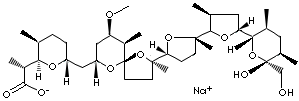|
NIGERICIN SODIUM |
| Nigericin sodium salt; Sodium nigericin; Antibiotic K 178; Antibiotic X-464; Azalomycin M; Helixin C; Polyetherin A; |
|
|
| PRODUCT IDENTIFICATION |
|
|
CAS RN |
28380-24-7 (parent), 28643-80-3 (sodium) |
|
EINECS RN |
|
|
FORMULA |
C40H67NaO11 |
|
MOLE WEIGHT |
746.94 |
|
CHEMICAL FAMILY |
Polyethers |
|
CLASSIFICATION |
Antibacterial, Antiinfective, Ionophores, Membrane Transport Modulator, Natural product |
|
|
| PHYSICAL AND CHEMICAL PROPERTIES |
|
|
PHYSICAL STATE |
white powder |
|
MELTING POINT |
264 - 265 C |
|
BOILING POINT |
|
|
DENSITY |
|
|
SOLUBILITY IN WATER |
Insoluble (Soluble in DMSO, partially soluble in methanol) |
|
pH |
|
|
VAPOR DENSITY |
|
|
REFRACTIVE INDEX |
|
|
FLASH POINT |
|
|
|
| STABILITY AND REACTIVITY | |
| STABILITY | Stable under normal conditions |
|
INCOMPATIBILITIES |
Strong acids, Strong bases |
| DECOMPOSITION PRODUCTS |
Carbon oxides, Sodium oxides |
| POLYMERIZATION | |
|
TOXICOLOGICAL |
|
|
|
|
POTENTIAL HEALTH EFFECTS |
|
|
HAZARD OVERVIEW |
Toxic if swallowed. Irritating to eyes, respiratory system and skin. |
|
EYE |
Causes eye irritation. |
|
SKIN |
May be harmful if absorbed through skin. May cause skin irritation. |
|
INGESTION |
Toxic if swallowed. |
|
INHALATION |
May be harmful if inhaled. Cause respiratory tract irritation. |
| TARGET ORGANS |
|
|
|
| TRANSPORT & REGULATORY INFORMATION |
|
|
UN NO. |
3462 |
| HAZARD CLASS |
6.1 |
| PACKING GROUP |
III |
| HAZARD SYMBOL |
T |
|
RISK PHRASES |
25-36/37/38 |
|
SAFETY PHRASES |
26-36/37/38-45 |
|
|
| EXTERNAL LINKS & GENERAL INFORMATION | ||||||||||||||||||||||||||||||||||||||||||||||||
|
Wikipedia Linking: http://en.wikipedia.org/wiki/Nigericin Ionophore is a relatively small hydrophobic molecule that facilitates the transport of ions across lipid membranes. Most ionophores are produced by microorganisms. There are two types of ionophores: channel formers, which combine to form a channel in the membrane through which ions can flow; and mobile ion carriers, which transport ions across a membrane by forming a complex with the ion. (http://www.ktf-split.hr/)olyether ionophores, such as nigericin, abierixin, monensin A, and nanchangmycin, constitute a family of over 120 structurally related natural products with the ability to selectively chelate metal ions and transport them across cell membranes. For example, nigericin, first described in 1951, exerts diverse potent effects on cells through its ability to mediate neutral H+/K+ exchange across biological membranes. Polyethers have widespread application in veterinary medicine and animal husbandry and more recently have been identified as agents with activity against drug-resistant strains of malaria. Two polyether biosynthetic gene clusters have so far been characterized, namely, those encoding the biosynthesis of monensin A and nanchangmycin (dianemycin), respectively. The information obtained from a detailed examination of these biosynthetic clusters has begun to shed light on the mechanism of polyether biosynthesis, and in particular the oxidation of the polyketide chain and its subsequent cyclization to form the characteristic ether rings. (http://www.sciencedirect.com/) Monensin, nigericin, and tetronasin inhibited the rate of biohydrogenation of linoleic acid. Continuous infusion of C18:2n-6 at a steady-state concentration of 314 µg/ml into fermenters receiving monensin, nigericin, or tetronasin resulted in lower amounts of stearic acid and higher amounts of oleic acid. Ionophores increased total C18:2 conjugated acids mainly because of an increase in the cis-9, trans-11-C18:2 isomer. If reflected in milk fat, ionophore-induced changes in ruminal lipids could enhance the nutritional qualities of milk. (http://jds.fass.org/) The K+ ionophore nigericin is shown to be highly effective as an ionophore for Pb2+, but not other divalent cations, including Cu2+, Zn2+, Cd2+, Mn2+, Co2+, Ca2+, Ni2+, and Sr2+. Among this group a minor activity for Cu2+ transport is seen, while for the others activity is near or below the limit of detection. The selectivity of nigericin for Pb2+ exceeds that of ionomycin or monensin and arises, at least in part, from the high stability of nigericin-Pb2+ complexes. Plots of log rate vs. log Pb2+ or log ionophore concentration, together with the pH dependency of transport and complexation, indicate that nigericin transports Pb2+ via the species PbNigOH, and by a mechanism that is predominately electroneutral. (http://www.umich.edu/)
|
|
|
| SALES SPECIFICATION |
|
|
APPEARANCE |
white powder |
|
CONTENT |
98% min (HPLC) |
|
|
| PRICE |
